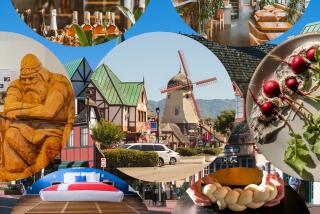Holiday shopping in Greenland
Christmas was coming, and I was headed north to the Arctic Circle on Santaâs direct route. I was at the beginning of a 12-day expedition cruise aboard the MV Fram around the southern tip of Greenland, the largest noncontinental island on Earth. Friends and family in L.A. had made me promise to return with unusual Christmas gifts, imagining polar bears in my pocket or baby harp seals in my backpack. To them, Greenland was more exotic than Timbuktu.
Here I was, at the back of beyond, in Maniitsoq, a small town on Greenlandâs west coast. In front of its tiny white wooden church, tables had been set up to display handcarved jewelry, decorated boxes and traditional water buckets painstakingly pegged together from driftwood and covered with ivory and bone amulets.
One of the native Inuit vendors, a young woman with amber eyes, turned to me and asked in careful English, âWhere are you from?â
â Los Angeles,â I told her.
A smile lighted her face. âIâve been there. Itâs very big.â
So was my surprise. Greenland may seem remote to a native Angeleno, but Greenlanders know more about the world than I had expected. Her name was Parnuna Paulsen, and her intricate carvings were my introduction to Christmas shopping in one of the worldâs most fascinating places.
PLANNING YOUR TRIP
HOW THE WRITER GOT TO GREENLAND
Hurtigruten Cruise Line offers a âTale of Two Ice Landsâ 12-day Greenland cruise, beginning July 10. Prices begin at $5,302. For details, go to https://www.hurtigruten.us/Greenland-Cruises. Hapag-Lloyd Cruises, Holland America Line and Princess Cruises also make port calls in Greenland.
TO LEARN MORE
There are so many one-of-a-kind handcrafted items to choose from that shopping here is a treasure hunt. The indigenous Inuits live by hunting sea mammals and reindeer, but during long winter nights the careful carving of bone, horn, tusk, tooth and claw is a national pastime. Designs are graceful and powerful, large and small, traditional and avant-garde. Inuit handicrafts offer great shopping opportunities, but the hunt can be tricky. Articles made from sea mammals canât be imported into the U.S., but fortunately there are beautiful carvings in ivory-colored reindeer or caribou antler, marbled pink musk ox horn, soapstone and wood that can. Just be sure to ask about the material used and have the seller write it on your receipt. Most shops will give you a government-approved certificate for customs.
The most popular free-standing carvings are traditional Inuit tupilaqs, small, grotesque figures that resemble Hawaiian tikis. In Greenlandâs capital of Nuuk, on the west coast, two shops have large collections of quality carvings by local artists, Anori Art, on the hill above the Greenland National Museum, and Tupilaq Craft & Furs, diagonally across from the Katuaq Cultural Center. Tupilaqs sell for $95 on up, while other sculptures sell for $80 for a 6-inch soapstone carving of a whaleâs flukes, an Inuit magical totem, to $800 for works in bone or horn by name artists. Beautifully carved pendants of traditionally dressed Inuits, polar bears, whales and abstract natural forms in bone or horn cost from $50 to $100.
In Tasiilaq, the largest town on the eastern coast, the best shop is Arctic Art. Here I found Inuit wooden masks for $600, traditional beadwork necklaces for $25, contemporary multicolored belts of intricately woven leather, called avittat, for $156, and for $1,300 a detailed model of an Inuit seal hunter in his kayak complete with miniature hunting equipment. The ulu, or womanâs knife, is another indigenous motif that occurs in jewelry. For an Inuit woman, the ulu is an extension of her hand, a personal tool that ties her to her culture. In Maniitsoq, Paulsen was selling a silver and bone miniature pendant ulu for $100. At Anori Art in Nuuk, a sterling pendant ulu was $52, and at Arctic Art in Tasiilaq, the ulu was represented in miniature bone earrings for $50.
Greenland also mines unusual stones, a pinkish-violet stone called Reindeerâs Blood, unique to the country; the dark brown nummit; the clear green gronlanditten; and a light blue lapis lazuli. Although the jewelry isnât as intricate or as plentiful as the carvings, pendants and earrings make unusual gifts. Depending on the quality and size of the stones, jewelry can sell for less than $100 to a great deal more.
For Greenlanders, the material used to shape a piece of art is part of the land itself. The form the artist chooses gives it identity and connects it to the culture that produced it. I came home from Greenland with Christmas presents so unique, my family actually forgave me for not bringing back a polar bear.
More to Read
Sign up for The Wild
Weâll help you find the best places to hike, bike and run, as well as the perfect silent spots for meditation and yoga.
You may occasionally receive promotional content from the Los Angeles Times.






